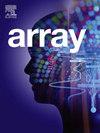An optimal weighting-based hybrid classifier for Children's congenital heart diseases signal processing
IF 4.5
Q2 COMPUTER SCIENCE, THEORY & METHODS
引用次数: 0
Abstract
Classification is one of the most prominent modeling approaches that can be successfully applied in model-based medical support systems to make more accurate diagnostic decisions. The classification literature indicates that numerous classifiers with different characteristics have been developed and frequently applied across a wide range of medical diagnostic processes. Several features of a classifier, such as accuracy, reliability, and complexity, can be considered when choosing the most appropriate classifier for modeling purposes in a medical decision support system. Among these features, classification accuracy is one of the most critical due to its significant impact on the quality and precision of medical diagnoses. However, achieving accurate results, especially in the medical domain which often contains complex and mixed patterns, is still a commonly difficult task. Hybridization is among the most popular techniques frequently used in the classification literature to enhance accuracy. In this paper, a hybrid classifier incorporating Long Short-Term Memory (LSTM), Support Vector Machine (SVM), and Convolutional Neural Network (CNN) is proposed and applied to diagnose congenital heart disease in children. The most distinguishing feature of the proposed hybrid classifier compared to existing ones is its optimal weighting algorithm. In this study, an optimal weighting algorithm is developed which, unlike previously proposed algorithms, can guarantee that the best accuracy will be achieved. The main objective of the proposed optimal weighting-based CNN-LSTM-SVM (OCLS) hybrid classifier is to simultaneously leverage the unique advantages of CNN in feature extraction from input signals, LSTM in modeling the sequential patterns of signals, SVM in classifying regular patterns, and especially the proposed weighting algorithm to optimally integrate the outputs of these components. Experimental findings based on the Children's Congenital Heart Disease benchmark dataset demonstrate that the proposed hybrid classification model outperforms its individual base classifiers. Furthermore, it delivers superior accuracy compared to several recently introduced hybrid models in the existing literature. Notably, the proposed method also outperforms CNN-LSTM-SVM combinations that use conventional weighting strategies such as Simple Average (SA), Majority Voting (MV), and metaheuristic optimization algorithms. Numerical results illustrate that the proposed hybrid classifier can, on average, improve the classification rate and diagnostic capability by 7.09 %, 13.60 %, 5.52 %, and 6.84 % compared to its individual components, other single shallow or deep statistical or intelligent classifiers, other weighting-based parallel hybrid classifiers, and other recently developed classifiers for congenital heart disease diagnosis, respectively. In addition, these improvements are not limited to the classification rate. The obtained results indicate that the proposed classifier can, on average, enhance performance by 6.46 %, 10.35 %, 8.37 %, and 6.22 % in precision, sensitivity, F1-score, and specificity, respectively. Consequently, it can be concluded that the proposed OCLS hybrid classifier can be an efficient alternative approach for the diagnosis of heart signal-based diseases.
儿童先天性心脏病信号处理的最优加权混合分类器
分类是最突出的建模方法之一,可以成功地应用于基于模型的医疗支持系统中,以做出更准确的诊断决策。分类文献表明,已经开发了许多具有不同特征的分类器,并经常应用于广泛的医学诊断过程。在医疗决策支持系统中为建模目的选择最合适的分类器时,可以考虑分类器的几个特征,如准确性、可靠性和复杂性。在这些特征中,分类精度是最关键的特征之一,因为它对医疗诊断的质量和精度有重要影响。然而,获得准确的结果,特别是在经常包含复杂和混合模式的医学领域,仍然是一项普遍困难的任务。杂交是在分类文献中最常用的技术之一,以提高准确性。本文提出了一种结合长短期记忆(LSTM)、支持向量机(SVM)和卷积神经网络(CNN)的混合分类器,并将其应用于儿童先天性心脏病的诊断。与现有的混合分类器相比,所提出的混合分类器最大的特点是其最优加权算法。在本研究中,开发了一种最优加权算法,与以往提出的算法不同,该算法可以保证获得最佳的精度。本文提出的基于最优加权的CNN-LSTM-SVM (OCLS)混合分类器的主要目标是同时利用CNN在输入信号特征提取、LSTM对信号序列模式建模、SVM对规则模式分类等方面的独特优势,特别是利用所提出的加权算法对这些分量的输出进行最优整合。基于儿童先天性心脏病基准数据集的实验结果表明,所提出的混合分类模型优于其单个基分类器。此外,与现有文献中最近引入的几种混合模型相比,它提供了更高的准确性。值得注意的是,该方法还优于CNN-LSTM-SVM组合,后者使用传统的加权策略,如简单平均(SA)、多数投票(MV)和元启发式优化算法。数值结果表明,与单个成分分类器、其他单一浅层或深层统计分类器或智能分类器、其他基于权重的并行混合分类器和其他最近开发的先天性心脏病分类器相比,所提出的混合分类器的分类率和诊断能力平均分别提高了7.09%、13.60%、5.52%和6.84%。此外,这些改进并不局限于分类率。结果表明,本文提出的分类器在精度、灵敏度、f1评分和特异性上平均分别提高了6.46%、10.35%、8.37%和6.22%。因此,可以得出结论,所提出的OCLS混合分类器可以成为基于心脏信号的疾病诊断的有效替代方法。
本文章由计算机程序翻译,如有差异,请以英文原文为准。
求助全文
约1分钟内获得全文
求助全文

 求助内容:
求助内容: 应助结果提醒方式:
应助结果提醒方式:


